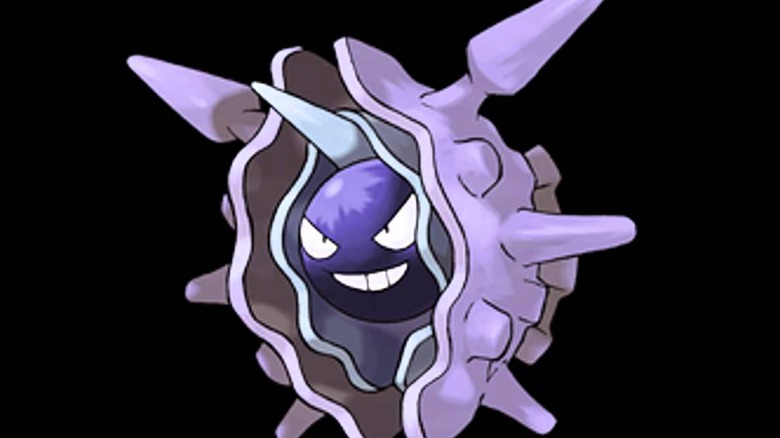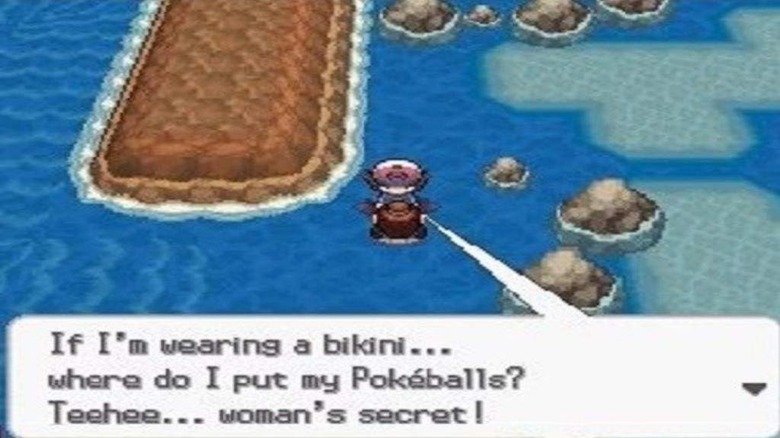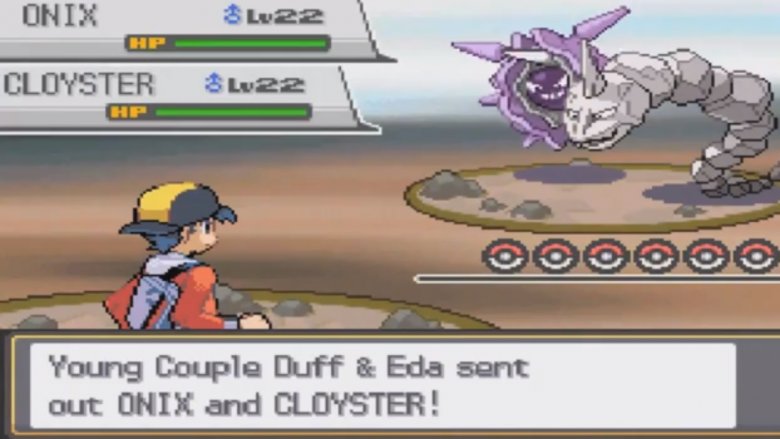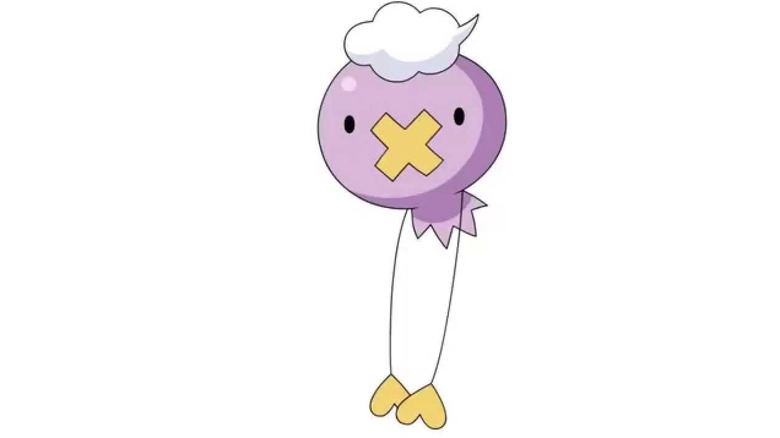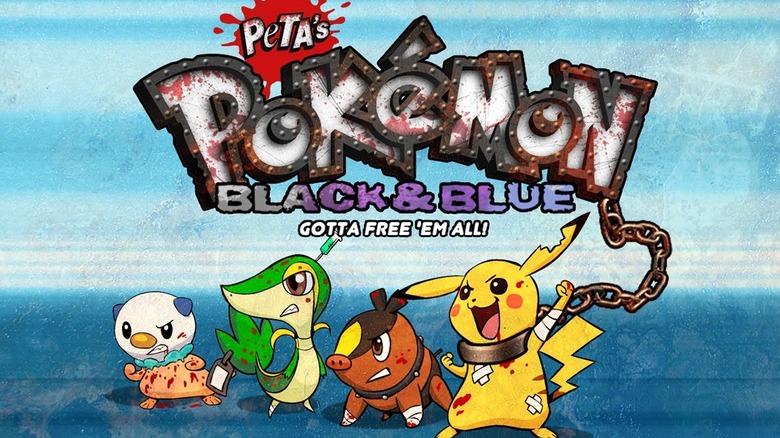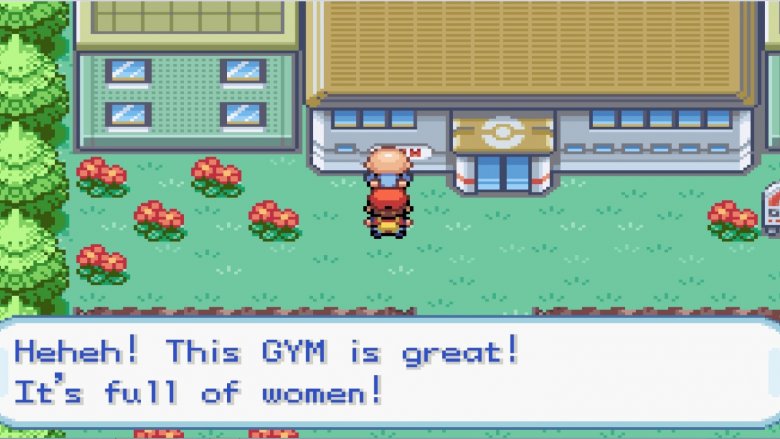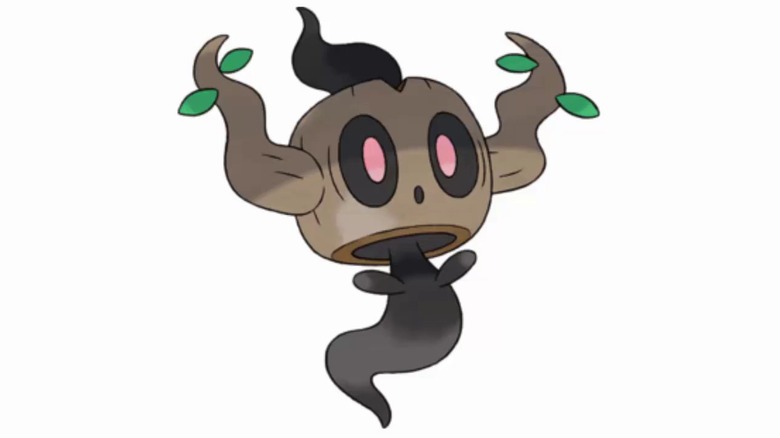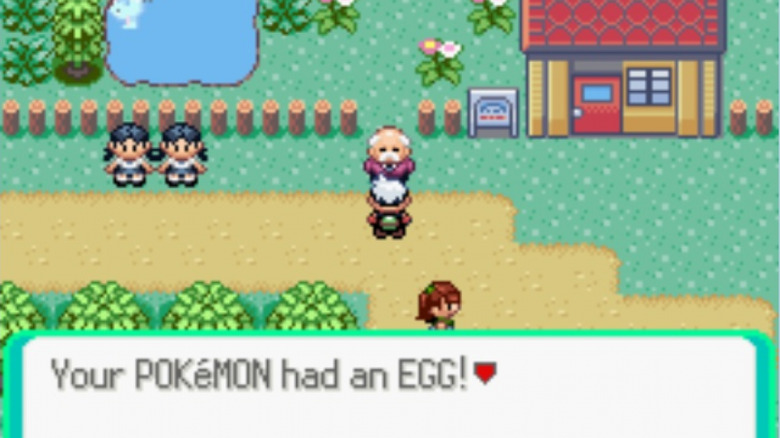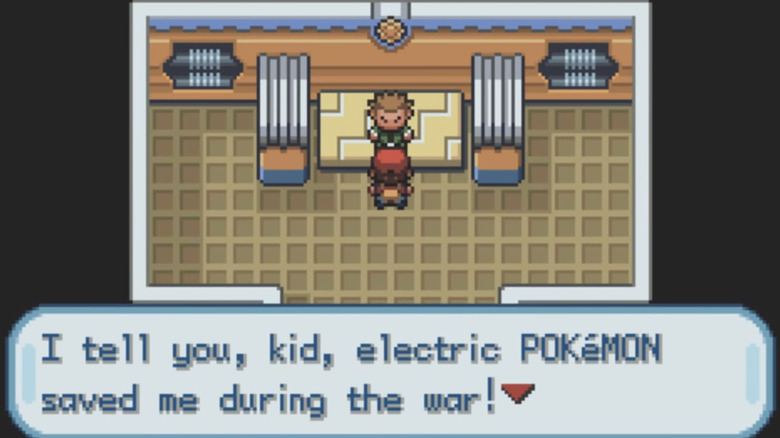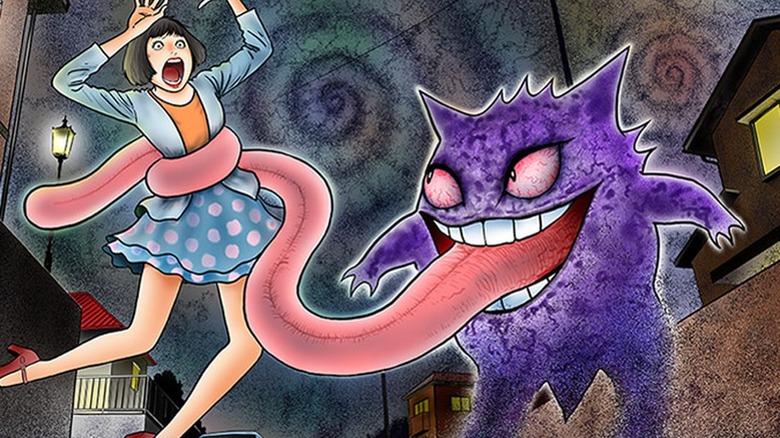Things Only Adults Notice In Pokemon
Pokemon started as a reflection of creator Satoshi Tajiri's own childhood spent in the Japanese countryside, doing the things children do. For Tajiri, that was exploring tall grass and catching the critters within, namely bugs. When Pokemon Red and Blue released in 1996, people of all ages were going on virtual adventures into pixelated fields to catch Caterpies and Weedles.
Eventually, the children who first played the games grew up to the realization that there were some un-PG tidbits lurking throughout the series: an innuendo here, a dark suggestion there. The adult content in Pokemon is subtle, but nevertheless present in both older and newer generations of the games. Pokemon will always have a young demographic of players, but according to one GameFAQs poll, the player base for the latest title of the series skews toward over 18s. It's these players who catch onto the fact that the world of Pokemon isn't as innocent as it seems.
Bikini girls and Pokeballs
Swimming is a totally innocent activity. Swimsuits are entirely innocuous pieces of clothing required for the activity. Players should expect to run into trainers wearing swimsuits when surfing around in the ocean areas of Pokemon; there's nothing inherently suggestive about having a friendly battle with a girl in a bikini. That is, until you run into lines like this:
"If I'm wearing a bikini... where do I put my Pokeballs? Teehee... woman's secret!"
We don't know any women who know this secret, either.
This particularly spicy flavor text appears in Pokemon Black and White when a Swimmer approaches you looking for a battle. It's a valid question as to where Swimmers stash their gear while in the water. Losing your Pokeballs beneath the waves would be terrible.
But unless the secret here is a handy fanny pack, the seriously sexual undercurrent to this otherwise flippant remark is terrible. And this isn't the only instance of a Swimmer hinting at the X-rated location of where they keep their Pokeballs. Pokemon Sun and Moon is rife with Swimmers, including one who coyly says, "It's tough fetching Poke Balls from my bikini!"
The couple with a Cloyster and Onix
There are plenty of couples in Pokemon, most keeping the PDA to a PG minimum. The only kissing players see is by Fairy types planting Sweet Kisses on their opponents. Usually these couples have nauseatingly adorable matching Pokemon, like a Miltank and a Tauros or two Pokemon of the same type. There's one over-the-top pair in Emerald with their own two Luvdiscs. The VS portrait from AlphaSapphire and OmegaRuby have the Young Couple adorned in matching T-shirts, the Luvdiscs on them kissing each other as they embrace. It's all a little much, but overall their affection is just cute, unsuggestive that they might get up to anything other than cuddles and kisses.
Young Couple Duff and Eda in HeartGold and SoulSilver are also fawning all over each other, but their choice of Pokemon seems to suggest that they've taken their relationship to the next level (no pun intended). Out on Route 47, they're ready to battle with Duff's Onix and Eda's Cloyster. The designs of these Pokemon — especially Cloyster's — have been riffed on individually, but together they serve as a wholly new innuendo.
That increasingly smaller player base under 18 probably won't bat an eye at this battle.
Drifloon hates fat kids
Stephen King's infamous grinning nightmare clown from the newly rebooted IT might be the inspiration behind the cute, floaty Ghost type Drifloon. While it's not clown nose-red, the Pokemon looks like a balloon, and is often mistaken as such by children. This can prove fatal, as many of Drifloon's Pokedex entries note that children holding onto them sometimes vanish.
It's unclear as to whether or not these disappearances are intentional kidnappings. Some titles suggest that it's just a mystery as to what happens to these missing kids. Others make it clear that Drifloon targets children. Pokemon Sun pulls no punches, saying that, "It dislikes heavy children."
Parents playing the game might see an even more nefarious motivation behind Drifloon's penchant for skinny kids. In kidnappings, cute things are often used by creeps to lure in children, making them feel comfortable with running off with a stranger. Drifloon seems like the perfect companion to a kidnapper. Drifloon could be taken as a metaphor for spiriting kids away to a windowless van — something only an adult might notice, and a parent might feel squeamish about in a kids' game.
Pokemon is basically dog fighting
Wouldn't it be cool if Pokemon were real? Imagine being able to go on your own journey: catching Pokemon, battling fierce opponents, and earning cash upon victory. Well, it turns out all this is real. It's called dog fighting, is horribly cruel, and casts a shadow on the Pokemon series.
When you take the game out of context, it sounds downright horrific. Even the fight scenes in the Pokemon Origins anime are pretty graphic. Urging adorable Pokemon to bite, burn, and slash at each other isn't near as fun when you see it happening outside of simplified animations on a GameBoy. What really happens when Pokemon faint, anyway? Surely there's no way a Pokemon that's basically a melting ice cream cone could survive an attack that's literally called Flamethrower from a dragon.
The series scrubs away all the blood and guts that would logically come along with a game about fighting animals. In Pokemon, the creatures are eager to fight, they befriend and love their masters after being overpowered and captured by them, and they're miraculously healed with a quick trip to the Pokemon Center.
In a very Team Plasma-like move, animal rights organization PETA wanted to provide players with an alternative game that highlighted the abusive nature of Pokemon battles, aptly named Pokemon Black and Blue.
The peeping tom in Red and Blue
In Pokemon Red and Blue, Celadon City's gym is home to the "nature-loving princess" Erika, who stands between the player and the Rainbow Badge. To obtain the Rainbow Badge, the player must first defeat all the other trainers in the gym. In this case, the Celadon Gym has all female trainers: Lasses, Beauties, and Cooltrainers.
It seems like wherever women gather, perverts are soon to follow. Even the world of Pokemon isn't safe from the leering gaze of a lecherous old man. Right before the player enters the gym, there is an old man stationed outside, gazing into a tiny pixel window. Unabashed, he tells the player, "Heheh! This Gym is great! It's full of women!"
Peeking in a window of a gym might seem innocent enough, but for older players this invokes images of peeping toms looking through bedroom windows at unsuspecting women as they change clothes. It's not the best thing to be associated with a Nintendo game.
That's probably why later versions of the game took on some sensitivity training and instead have the old man saying, "Ha ha! This Gym is great! It's full of strong Trainers," in FireRed and LeafGreen titles.
Pokemon that were once human
The origins of Pokemon are fairly mysterious, but most Ghost types come with a horror story as to how they came into being. It's no coincidence that you usually find them floating around graveyards and haunting locations that once hosted tragedy. Every video game these days seems to have some kind of theory about how the players are actually dead kids, but in Pokemon, that theory is absolutely correct.
Phantump is a huggable-looking Ghost/Grass type with glowing red eyes that peer out of his stump-head. Phantump is also the spirit of a dead child. Introduced in Pokemon X and Y, Phantumps come into being when the spirits of children who got lost and died in the forest possess stumps. Ultra Sun layers on the eerie details saying that these Pokemon accidentally create more of themselves by crying out in the voices of children, making the other, living kids that they just wanted to befriend become hopelessly lost.
Sad and spooky, but kids playing the game can handle ghost stories. But can they take on the ethical implications of capturing and subsequently battling with the spirit of a dead child? It's questionable at what point a spirit, trapped in this world, becomes a Pokemon and thus fair game for trainers. Maybe it's when the parents stop mourning for their lost child, when the last of "missing" posters flies away in the wind.
Breeding as a concept, especially for specific traits
Kids don't know about eugenics, but they might have a Box full of low IV Budews. While there doesn't seem to be anything evil about leaving a Pokemon with a Ditto at the Pokemon Day Care and waiting for them to seem to "get along," there should be a moral dilemma with pimping out Pokemon to an amorphous blob in the pursuit of the perfect specimen.
Breeding comes with casualties. While Pokemon can sit in limbo on computers, the practice of breeding for competitive level IVs and other features worryingly bears a resemblance to the same practices that have dogs in squalid conditions, forced to produce litter after litter for the sake of purebred pups to be put in pet shop windows.
When looking for perfect IVs, players sometimes will then breed Pokemon that were produced with promising stats to the high IV Ditto they're probably using. Again, kids probably don't have the best grasp on the concept of incest, and then the malformed results of it, but they're just doing their best to find that ideal Klefki.
Your dad was killed in the war
Ever wonder as to why any self-respecting in-game parent would allow their naive little ten-year-old to go out unsupervised into the world? As with many things in Pokemon, there's a theory to answer that. And it's a pretty bleak idea.
The popular "Kanto War Theory" surfaced as a creepypasta to explain why there seems to be something slightly ... off about the people and places of the original generation of Pokemon games. The fatherless player's mother accepts their decision to go out on their own. Your rival is an orphan. There's hardly any adults other than older folks and those associated with the military.
Simplistic design or allusions to a post-war generation?
The lynchpin of this theory is Lt. Surge, who refers to Pokemon having saved him during the war. The whole concept of war is on a different scale in the Pokemon world. Some powerful Pokemon may as well be weapons of mass destruction. What kind of havoc would a Pokemon war wreak on the environment? On a whole region's people?
While this theory isn't directly confirmed or dismissed, the inklings of it come with some heavy concepts that the average ten-year-old may not be equipped to handle. There was no Nurse Joy to save Red's father on the battlefield.
Pokemon who prey on people
It's a wonder that Pokemon don't rule the world. They have way more power than the average human being. Even sentient ice creams and trash bundles wield impressive powers. People have Pokeballs and a whole lot of determination, but that's about it. If the player went out into the wilderness without their partner Pokemon, they'd probably be food for Fearrows.
Because Pokemon eat people. Or at least attack and kill them, as evidenced by some Dark type's Pokedex entries. While Gengar just appeared to be a kind of trickster spirit in the first generation, things escalated rather quickly in the second generation when the phrase "to steal the life of its target" was used to describe its hunting and stalking of people lost in the mountains. Ditto with Cacturne, who hunts at night, trailing behind tired travelers in a gang, waiting for them to become too exhausted to move.
It's foggy as to what's more concerning: that in-game ten-year-olds are out and up against these predators, or that they catch and befriend what could be equated to serial killers. These are dangerous creatures, and while they might be loyal to their trainers, does that loyalty extend to their friends and family? Maybe there are some headlines in Kanto about a young trainer's Gengar getting loose and stealing the souls of the neighbors. Regardless, seeing a child with a dead-eyed Cacturne makes them hanging out with a tempermental, flame-tailed dragon like Charizard seem age-appropriate after all.

